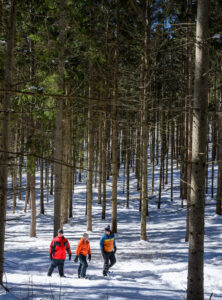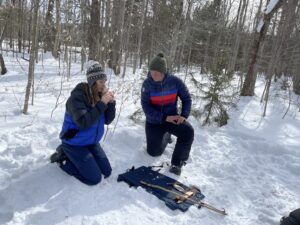 Wilderness therapy offers a rich learning environment, and exploring new behaviors is a critical part of developing personal insight and a positive sense of self. There are moments where many students at True North do something that would have normally landed them in trouble at home. However, in the wilderness therapy environment, these moments become opportunities, where course leaders are able to act in a way that teachers, parents, or other authority figures typically don’t. In these moments, sometimes the best action is to do nothing at all. If a student refuses to get out of their sleeping bag, instead of imposing consequences or offering a reward for positive behavior, doing nothing gives the student space to discover the solution to their problem. They are in control, and need to problem solve a way to get their needs met. True North guides and course leaders won’t replay the pattern that parents often fall into- the common power struggle or nagging that may ensue at home.
Wilderness therapy offers a rich learning environment, and exploring new behaviors is a critical part of developing personal insight and a positive sense of self. There are moments where many students at True North do something that would have normally landed them in trouble at home. However, in the wilderness therapy environment, these moments become opportunities, where course leaders are able to act in a way that teachers, parents, or other authority figures typically don’t. In these moments, sometimes the best action is to do nothing at all. If a student refuses to get out of their sleeping bag, instead of imposing consequences or offering a reward for positive behavior, doing nothing gives the student space to discover the solution to their problem. They are in control, and need to problem solve a way to get their needs met. True North guides and course leaders won’t replay the pattern that parents often fall into- the common power struggle or nagging that may ensue at home.
As you can imagine, or maybe have even experienced, this same situation at home would likely look entirely different. Young people who don’t have strong control of their emotional wellbeing will often present with some sort of behavior that is begging for recognition of a need going unmet. However, it usually is seen as defiant, oppositional, or problematic behavior. This often leads to issues with dysfunction in the young person’s life that requires intervention. When students arrive at True North, they are often used to being “in trouble” and they quickly test the limits within the programmatic context to find where the “trouble” zone is. Having been adept at finding the “trouble zone” quite easily at home and at school, students are often quick to reinforce negative beliefs- “I am the problem. I am worthless. No one should love me.” The thoughts feed a negative feedback loop surrounding self beliefs, sucking an adolescent into a dark and lonely place.
 But, what happens when the adolescent bumps up against a limit that isn’t there? Back to the example of staying in their sleeping bag; we allow time to be the natural consequence. The rest of the group expresses care and support, and goes on with their day. Course leaders and guides help the young person see that dysfunctional behavior of shutting down in their sleeping bag isn’t going to help them successfully meet a need anymore. We don’t say “if you don’t get out of that sleeping bag you’ll be grounded,” or “if you come out i’ll take you to the movies.” We allow them to discover that their behavior isn’t serving them anymore, and further, they are able to reflect on ways this pattern has emerged in their lives, and how it has played a role. The environment is rich with lessons that put the adolescent in control in a positive way and creates insight. You can’t scream at the rain to make it stop. You can’t sleep all day without collecting firewood, and stay warm. We often don’t have to provide resistance to a student’s behavior because the resistance comes from the wilderness itself. You can’t argue with it, it just is.
But, what happens when the adolescent bumps up against a limit that isn’t there? Back to the example of staying in their sleeping bag; we allow time to be the natural consequence. The rest of the group expresses care and support, and goes on with their day. Course leaders and guides help the young person see that dysfunctional behavior of shutting down in their sleeping bag isn’t going to help them successfully meet a need anymore. We don’t say “if you don’t get out of that sleeping bag you’ll be grounded,” or “if you come out i’ll take you to the movies.” We allow them to discover that their behavior isn’t serving them anymore, and further, they are able to reflect on ways this pattern has emerged in their lives, and how it has played a role. The environment is rich with lessons that put the adolescent in control in a positive way and creates insight. You can’t scream at the rain to make it stop. You can’t sleep all day without collecting firewood, and stay warm. We often don’t have to provide resistance to a student’s behavior because the resistance comes from the wilderness itself. You can’t argue with it, it just is.
These seemingly small learning opportunities are often a turning point for a student where they recognize a desire to try something new. A student asked me recently if they were “in trouble” after refusing to get out of bed one day. I told them we aren’t the police; we’re here to support their needs and help them discover what works for them. Weeks later the same student expressed gratitude toward the True North approach. We respect each student’s individual process, and mistakes are an important part of learning. Luckily we operate in a context where there is safety in trying, failing and trying again. Over time, developing insight and practicing behaviors that get their needs met in a healthy way feeds a positive feedback loop- reinforcing self beliefs that “I am worthy. What I do matters. I am in control of my life.”


